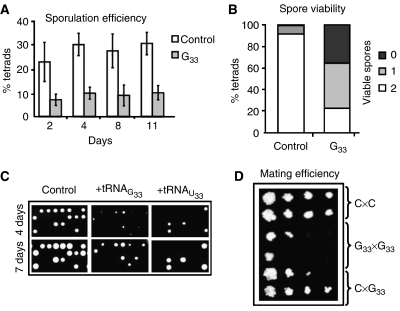Figure 2.
Genetic code alterations act as a barrier for sexual reproduction. The ability of S. cerevisiae cells expressing C. albicans G33 tRNACAGSerto reproduce sexually was determined by their sporulation and mating efficiencies. (A) The number of tetrads produced by diploid ambiguous cells decreased by 30% when compared with control cells, indicating that sporulation efficiency was lower in CUG ambiguous cells. (B) Spore viability was reduced in ambiguous cells, since most tetrads yielded only one (42%) or no viable spores (35%), while tetrads from control cells produced mainly two viable spores (92%). (C) Ambiguous cells produced fewer viable spores and spores grew slower, as shown by growth on solid selective medium. The U33 tRNA spores shown had mutations in the tRNACAGSer gene. (D) Haploid control and ambiguous cells with opposite mating types were mixed and serial dilutions of the mixtures were plated onto selective media. C × C, G × G and C × G indicate the crosses between the control cells, or ambiguous G33 tRNA cells or control and ambiguous G33 tRNA cells, respectively. The reduced amount of diploids produced by crossing ambiguous (G33 tRNA) cell lines showed that mating efficiency was also negatively affected by CUG ambiguity. In all cases, the U33 tRNACAG was lethal in haploid backgrounds. Alternatively, its gene acquired mutations that inactivated the U33 tRNA.

